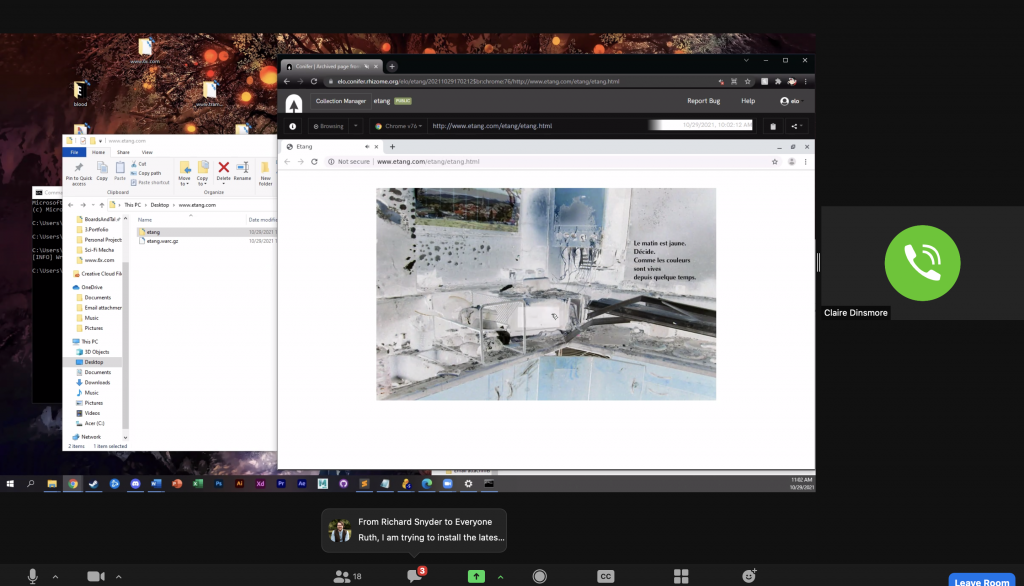On 27-28 October 2021 thirty-one artists and scholars from around the globe came together to learn about various methods for preserving Flash electronic literature and net art at the Resurrecting Flash Art workshop held by the lab via Zoom. The main methods we discussed were the ones the lab primarily uses for saving the Flash art for The NEXT: Ruffle and Conifer. We also invited prominent net artist Alan Bigelow to talk about the work he has done to migrate his early Flash art to open web languages and briefly discussed video documentation and Pale Moon browser as alternative methods for making the work available to the public and accessing it for research.
Day 1 of the workshop saw 26 participants work either in teams or independently using Ruffle. ELL Flash preservationist Arlo Ptolemy led the demonstration and discussion that followed. Using Flash net art donated to The NEXT by Reiner Strasser and works brought to the workshop by participants created by other prominent internationally-acclaimed Flash artists, we were able to preserve these 12 works:
Reiner Strasser’s “Beware”: https://eliterature.org/ruffle/flash-workshop/team10/beware/index.html
Reiner Strasser’s “Bamboo”: https://eliterature.org/ruffle/flash-workshop/team10/bamboo/index.html; https://eliterature.org/ruffle/flash-workshop/team11/panda/index.html
Jhave’s “Reboot the Universe”: https://eliterature.org/ruffle/flash-workshop/team7/jhave/reboot_Jhave/index.html
“Cartografi”: https://eliterature.org/ruffle/flash-workshop/team11/cartografi/cartografi1.html
Matt Hanson and Deena Larsen’s “Senzillament dic” (Italian title for “I’m Simply Saying”): https://www.salnitre.com/senzillament/senzillament33.html
Reiner Strasser’s “Tears”: https://eliterature.org/ruffle/flash-workshop/team11/war/tears.html
Reiner Strasser’s “War”: https://eliterature.org/ruffle/flash-workshop/team11/war/war.html
Nanette Wyde’s “The Qi Project”: https://eliterature.org/ruffle/flash-workshop/team7/nanettewylde_qiproject/index.html
Dominaziana Giordana and Reiner Strasser’s “The Doorman Passing “: https://eliterature.org/ruffle/flash-workshop/team4/doorman/index_dian.html
“Stillicidio”: https://eliterature.org/ruffle/flash-workshop/team11/stillicidio/tempo1.html
“Lost”: https://eliterature.org/ruffle/flash-workshop/team4/lost/Lost.html
“Tu/tto”: https://eliterature.org/ruffle/flash-workshop/team11/tutto/tutto.html
Because many of works we shared with the participants contained complex action scripting and/or video and sound, they were not able to be preserved with Ruffle. So, on Day 2, we concentrated our efforts on Rhizome’s Conifer, which can handle these features more readily.
 Day 2 saw 17 participants return to hear Alan Bigelow talk about his experience with migrating Flash art to HTML, CSS, and JavaScript and to learn from ELL’s Flash preservationist Andrew Thompson how to implement Conifer. Getting everyone set up for WARCIT was a challenge since participants were using both Macs and Windows computers and the process varied widely between them. Frankly, those of us using Macs in the lab had long been working with Conifer in preparation for the NEH proposal for the “afterflash” project and did not need to download Python on our computers to set up WARCIT. We found the directions found online for Windows did not work for us. Lyle Skains shared with us the documentation she produced for setting up Macs. [1] So, this section of the workshop saw less works saved than the previous day.
Day 2 saw 17 participants return to hear Alan Bigelow talk about his experience with migrating Flash art to HTML, CSS, and JavaScript and to learn from ELL’s Flash preservationist Andrew Thompson how to implement Conifer. Getting everyone set up for WARCIT was a challenge since participants were using both Macs and Windows computers and the process varied widely between them. Frankly, those of us using Macs in the lab had long been working with Conifer in preparation for the NEH proposal for the “afterflash” project and did not need to download Python on our computers to set up WARCIT. We found the directions found online for Windows did not work for us. Lyle Skains shared with us the documentation she produced for setting up Macs. [1] So, this section of the workshop saw less works saved than the previous day.
That said, the goals of the workshop were met in that we were able to 1) teach participants methods for preserving Flash art, 2) had a lively discussion about archival practice and theory about saving rich multimedia, interactive art created with obsolete proprietary software, and 3) laid the foundation for building a working community of scholars and artists who want to gather on a more regular basis to save Flash art.
I would like to acknowledge the contributions of the ELL Team: Greg Philbrook, our Tech Guru who handled all of the server-side set up and troubleshooting; Arlo Ptolemy and Andrew Thompson, our Flash Preservationists who led the demonstrations and discussions on both days; Richard Snyder, our Assistant Director who helped individual participants with their needs; Holly Slocum, our Project Manager who oversaw the Zoom organization and traffic among breakout rooms; and Ruth Woodcock, our web coder who also helped out on teams and gave advice.
Notes
[1] See Lyle’s directions at: https://www.evernote.com/l/AAw48V-23qVLrbawR5f2rpcU09er46VnoJc.

